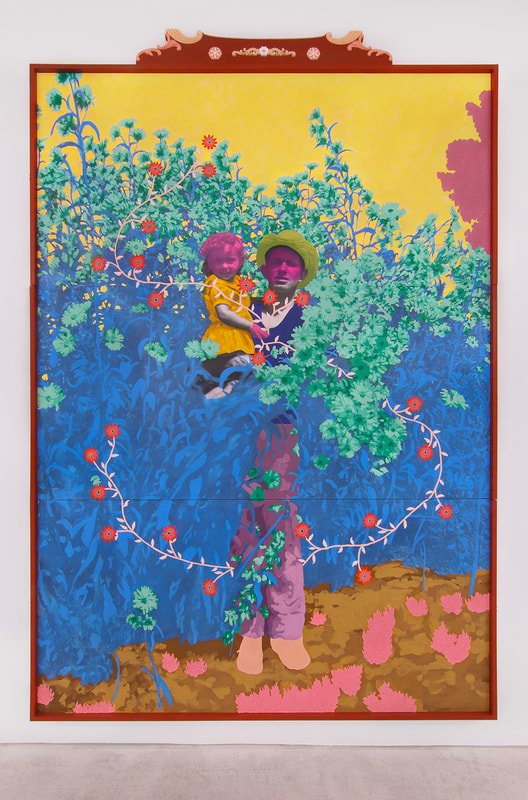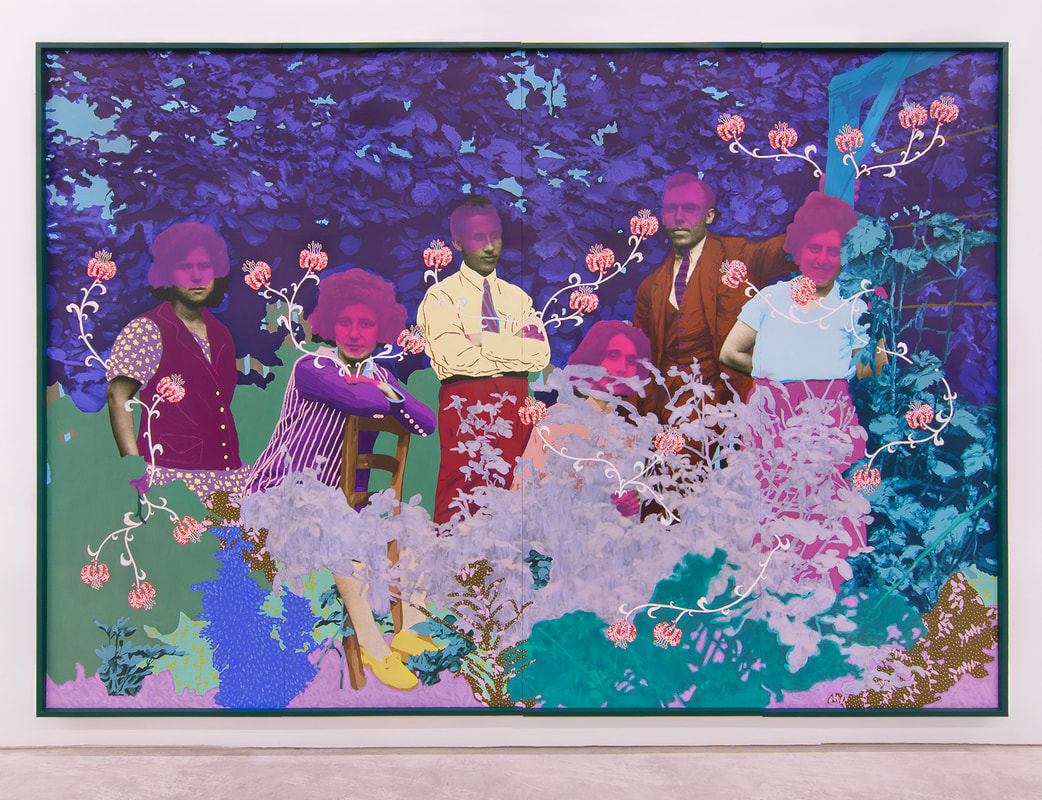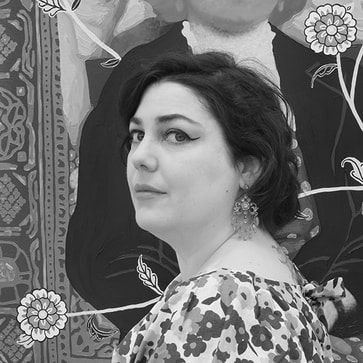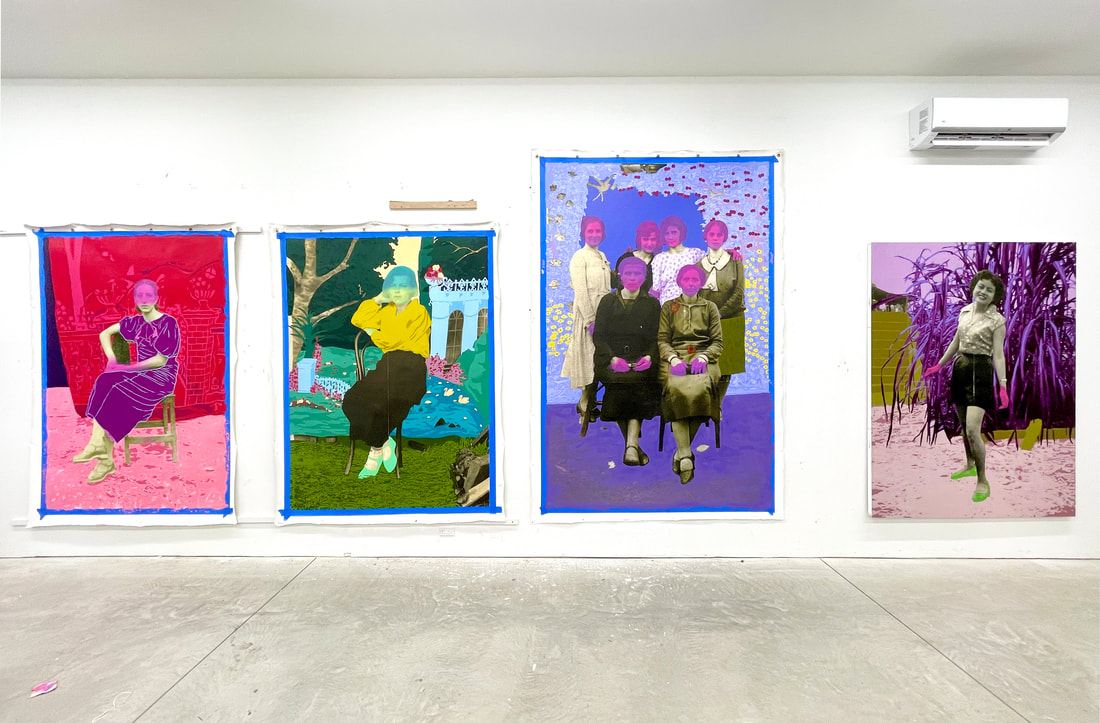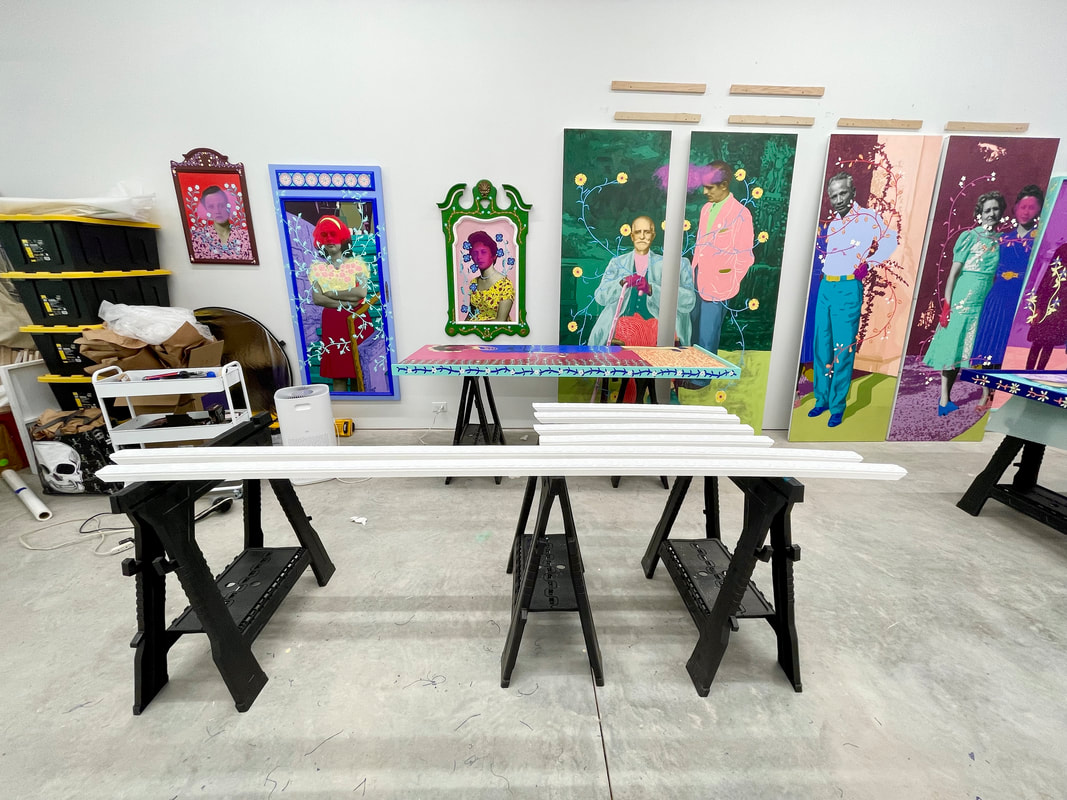Daisy Patton is a multi-disciplinary artist born in Los Angeles, CA to a white mother from the American South and an Iranian father she never met. Influenced by collective and political histories, Patton explores storytelling and story-carrying, social conventions of families, and what shapes living memory. Her work also examines in-between spaces and identities, including the fallibility of the body and the complexities of relationship and connection. Residing in western Massachusetts, Patton has exhibited nationally, including solos at the CU Art Museum at the University of Colorado, the Chautauqua Institution, and the Fulginitti Pavilion at the Center for Bioethics at the Anschutz Medical Campus, as well as group shows with MCA Denver, Spring/Break NYC, the Tampa Museum of Art, the Katonah Museum of Art, The Delaware Contemporary, the International Museum of Science and Art, among others. She has paintings in public and private collections such as the Denver Art Museum, Tampa Museum of Art, Seattle University, Fidelity Investments, and Delta Airlines. Patton’s work has been featured in publications such as Hyperallergic, The Jealous Curator, Transition Magazine, The Denver Post, The Chautauquan Daily, and more. Minerva Projects Press published Broken Time Machines: Daisy Patton, a book on Patton’s practice spring 2021. Patton has completed artist residencies at Anderson Ranch, the Studios at MASS MoCA, RedLine Denver, and Eastside International in Los Angeles. She was awarded a Massachusetts Cultural Council grant, a Barbara Deming Memorial Fund grant, an Assets for Artists Massachusetts Matched Savings grant, and a Montage Travel Award from SMFA. She earned her MFA from The School of the Museum of Fine Arts, Boston/Tufts University and has a BFA in Studio Arts from the University of Oklahoma with minors in History, Art History and an Honors degree. Foto Relevance represents her in Houston, TX, and K Contemporary in Denver, CO.
Published on March 3rd, 2024. Artist responses collected in months previous.
What are you working on these days?
This has been such a busy year—brand new work with creating altar-like frames for the “Forgetting is so long” series in a fall solo at new representation Koslov Larsen (formerly Foto Relevance) in Houston, TX, group shows at MCA Denver, Central Connecticut State University, CT State Community College Manchester, my piece in the Denver Art Museum collection was curated into the reinstallation of the modern/contemporary wing of the museum and will be in display for the next two years—it’s been a lot of great things! I am now in production mode for a solo in spring 2024 at Candela Gallery in Richmond, VA, a two-person show with Alicia Brown at the Augusta Savage Gallery at UMass Amherst, and some other exhibitions. So, basically a lot of stuff going on!
What has been going well for you in your art career and life recently?
The new studio has been such a gamechanger for me! I’ve been able to add woodworking, test out new techniques and ways of making the work, and create an exhibition that has gotten far more complicated in a timely fashion. I still need to figure out storage as my big problem left, but I am hoping to have a studio assistant to help with some of the tasks that are time-consuming and don’t require me, like hand sanding frames. My health has also stabilized (as long as I continue to avoid COVID), which means I’ve been able to dig into new directions in my practice overall.
What is something new that you have discovered this past year that is meaningful or helpful for you?
This has been the year of expanding the “Forgetting” series. I’ve learned a lot of carpentry skills to build frames, rehabbed found furniture items, and also am working with canvas and fiber arts in new works. In some cases, I’ve been waiting upwards of four years to make this kind of work, so that has been both stressful in terms of turning it around in time for exhibitions but also exciting—it feels like the universe of work I’m able to make has exploded outwards. I am heading towards incorporating sculptural and installation work into the series, which in some cases is a first for me! I’d felt quite stagnant and knew I needed to move forward in ways that felt out of reach, and having this studio has made all the difference. I also learned that my color work is strong enough to paint in the mostly dark when I lost power in the studio for two months due to an underground power line shorting. Being displaced for two months made the year all the more hectic!
Briefly walk us through your process of making art or thinking through a new project, focusing on what's most important to you as you create.
With the ongoing pandemic, I am more thoughtful in beginning work and sourcing materials. How will this work with limited help, i.e. just me and/or my spouse installing? I can’t look through various supplies in person, so I spend hours researching each material to determine if it can work and hope for the best. This ends up costing more because I will inevitably order something that seems like it would fit, only for it to arrive and be unsuitable. I’ve gotten very creative with stretching and repurposing materials, but in addition to cost, it takes much longer to make work than it did before because it has become more complex. So I devote a lot of time conceptualizing and planning than I have in previous years, which feels like taking off the autopilot and forging a new routes.
Is there anything else that you would like to share with our readers?
In addition to the massive expansion of my practice, I’ve also been trying to find more precise language and meaning for how I think and speak about my work. That means underlining the aspects of the sacred in the work, including influences like Persian mosques and Baroque Catholic churches, and incorporating other materials and their languages like tapestries and Persian rugs that underscore those connections. If I think about the “Forgetting” series as opportunities for connection and visitation, of the sacred, of living archives, of repair or pushing back against erasure, that has also extended to myself as well. I have been (slowly) learning Farsi this year as a form of repair and connection with my father’s heritage. This year has been tumultuous in so many ways, but all the challenges and ruptures I feel are leading me to creating some of the strongest work of my career thus far. The pandemic continues to make aspects of my career difficult, especially networking and connecting with others, but I feel optimistic about my practice and confident I am heading down a path I’ve been hoping to for a long time.
What are you working on these days?
This has been such a busy year—brand new work with creating altar-like frames for the “Forgetting is so long” series in a fall solo at new representation Koslov Larsen (formerly Foto Relevance) in Houston, TX, group shows at MCA Denver, Central Connecticut State University, CT State Community College Manchester, my piece in the Denver Art Museum collection was curated into the reinstallation of the modern/contemporary wing of the museum and will be in display for the next two years—it’s been a lot of great things! I am now in production mode for a solo in spring 2024 at Candela Gallery in Richmond, VA, a two-person show with Alicia Brown at the Augusta Savage Gallery at UMass Amherst, and some other exhibitions. So, basically a lot of stuff going on!
What has been going well for you in your art career and life recently?
The new studio has been such a gamechanger for me! I’ve been able to add woodworking, test out new techniques and ways of making the work, and create an exhibition that has gotten far more complicated in a timely fashion. I still need to figure out storage as my big problem left, but I am hoping to have a studio assistant to help with some of the tasks that are time-consuming and don’t require me, like hand sanding frames. My health has also stabilized (as long as I continue to avoid COVID), which means I’ve been able to dig into new directions in my practice overall.
What is something new that you have discovered this past year that is meaningful or helpful for you?
This has been the year of expanding the “Forgetting” series. I’ve learned a lot of carpentry skills to build frames, rehabbed found furniture items, and also am working with canvas and fiber arts in new works. In some cases, I’ve been waiting upwards of four years to make this kind of work, so that has been both stressful in terms of turning it around in time for exhibitions but also exciting—it feels like the universe of work I’m able to make has exploded outwards. I am heading towards incorporating sculptural and installation work into the series, which in some cases is a first for me! I’d felt quite stagnant and knew I needed to move forward in ways that felt out of reach, and having this studio has made all the difference. I also learned that my color work is strong enough to paint in the mostly dark when I lost power in the studio for two months due to an underground power line shorting. Being displaced for two months made the year all the more hectic!
Briefly walk us through your process of making art or thinking through a new project, focusing on what's most important to you as you create.
With the ongoing pandemic, I am more thoughtful in beginning work and sourcing materials. How will this work with limited help, i.e. just me and/or my spouse installing? I can’t look through various supplies in person, so I spend hours researching each material to determine if it can work and hope for the best. This ends up costing more because I will inevitably order something that seems like it would fit, only for it to arrive and be unsuitable. I’ve gotten very creative with stretching and repurposing materials, but in addition to cost, it takes much longer to make work than it did before because it has become more complex. So I devote a lot of time conceptualizing and planning than I have in previous years, which feels like taking off the autopilot and forging a new routes.
Is there anything else that you would like to share with our readers?
In addition to the massive expansion of my practice, I’ve also been trying to find more precise language and meaning for how I think and speak about my work. That means underlining the aspects of the sacred in the work, including influences like Persian mosques and Baroque Catholic churches, and incorporating other materials and their languages like tapestries and Persian rugs that underscore those connections. If I think about the “Forgetting” series as opportunities for connection and visitation, of the sacred, of living archives, of repair or pushing back against erasure, that has also extended to myself as well. I have been (slowly) learning Farsi this year as a form of repair and connection with my father’s heritage. This year has been tumultuous in so many ways, but all the challenges and ruptures I feel are leading me to creating some of the strongest work of my career thus far. The pandemic continues to make aspects of my career difficult, especially networking and connecting with others, but I feel optimistic about my practice and confident I am heading down a path I’ve been hoping to for a long time.
Find Daisy Patton on Instagram

